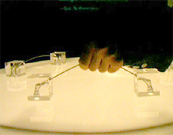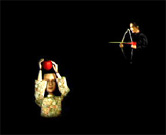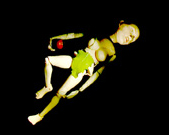In both its mathematical and figurative uses, the term “asymptote” describes a paradox: two elements, by nature incompatible, extend themselves nevertheless towards an infinite point at which their impossible contact can take place.
- Installation: Asymptote
- Concept + Design: Douglas Edric Stanley
- Exhibition: 1999 ICC Biennale, “Interaction”
- Location: NTT InterCommunication Center, Shinjuki, Tokyo
- Date: October 15 - November 28,1999
- Video: Asymptote video (mp4)
- Producer: NTT InterCommunication Center
- Sound Design: Julien Hô Kim
- Puppeteer: Liviu Berehoi, Teatrul Tandarica
- Technical assistant: Guillaume Stagnaro
- Production Assistant: Colette Stanley
- Sound Interface: Laurent Pottier, GMEM
- Interface construction: Armin Steinke, Ettlingen; Ets. Chabaud, Marseille
- Marionnettes: Les marionnettes de Genève (remerciments à John Lewandowsky)
- Production assistance: L’institut International de la Marionnette Charleville-Mézières, Laboratoire Esthétique de l’Interactivité, Paris 8, GMEM, L.O.E.I.L., Esc. to begin, ZKM


The installation Asymptote takes its point of departure from the narrative-essay On the Marionette Theater, written by Heinrich von Kleist in 1810. Although Kleist makes direct reference to the asymptote, his central allegory revolves around the similarly paradoxical relationship of the marionette and the marionettist, in which an object devoid of gravitational forces takes on the emotional weight of its operator, thus effectuating a transfer or translation between matter and the disjunctive imagination of the human subject. The operator’s gravity-bound gestures are uplifted into a state of grace, described by Kleist as a sort of spiritual prosthesis. The central conduit of this transfer takes place through the wire that both connects and divides the two worlds.


In the center of a darkened room: a small cylindrical pedestal. A series of thin wires connected to pulleys sit atop the cylinder, which in turn connect up to three computers lying in the cylinder chamber, and which are visible through the transparent glass of the top surface. The wires are tightly stretched and offer a force-feedback resistance when pulled. When the museum visitors pull these strings, a series of interactive video images projected onto the walls of the installation react to these interventions: appearing, disappearing and evolving according to the rhythm of the interactor’s gesture. By pulling on one of the strings violently, for example, the hand of a marionette appears, spinning in circles frenetically, hitting itself with each rotation. With another, softer, pull of the string, another marionette’s hand gently caresses a third marionette’s hair. Slowly, as the visitors pull and release the wires, an interactive narrative develops, based on stories from Kleists text.These stories are related, as in the text, through a dialogue that takes place between the narrator and a renowned ballet dancer the narrator happens to meet in a public park. As the interactor(s) activate the wire interface, this dialogue develops, takes unexpected turns, and eventually bifurcates to follow the digressions of the interactors interventions.
